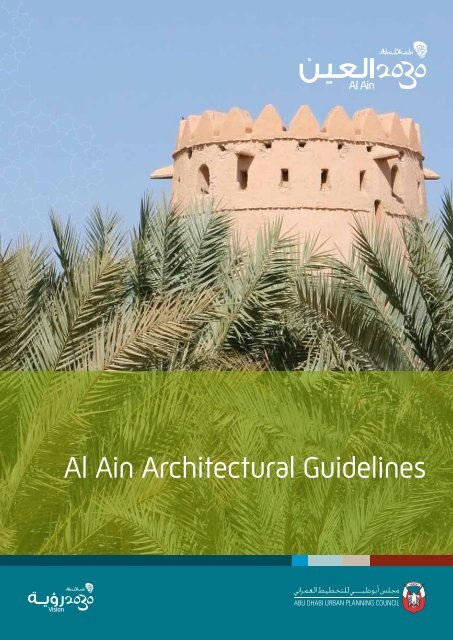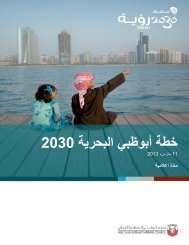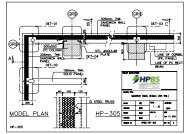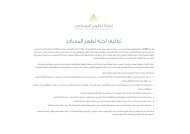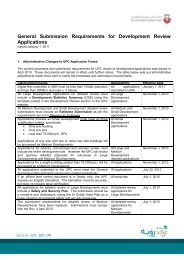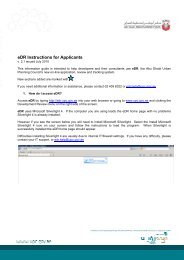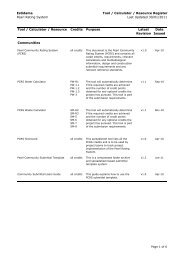Al Ain Architectural Guidelines
Al Ain Architectural Guidelines
Al Ain Architectural Guidelines
- No tags were found...
You also want an ePaper? Increase the reach of your titles
YUMPU automatically turns print PDFs into web optimized ePapers that Google loves.
<strong>Al</strong> <strong>Ain</strong> <strong>Architectural</strong> <strong>Guidelines</strong>
<strong>Al</strong> <strong>Ain</strong> <strong>Architectural</strong> <strong>Guidelines</strong>i
<strong>Al</strong> <strong>Ain</strong> <strong>Architectural</strong> <strong>Guidelines</strong>IntroductionThe plan for <strong>Al</strong> <strong>Ain</strong> is based on the idea of a “city in the oasis”. This overarchingconcept should find its way into the design of individual buildingsin the city, as well as their adjacent open spaces. The purpose of thisdocument is to provide explicit design direction towards the achievementof this goal.<strong>Al</strong> <strong>Ain</strong> has a history of development patterns, building types, constructionmaterials, textures and colours particular to its region. The designguidelines presented in this document, for both new and existing buildings,are inspired by this cultural history. At the same time, it is importantto avoid the literal adaptation of traditional styles and features appliedat the scale of the downtown. Equally important, westernised, “hightech”solutions that are out of context with the existing fabric, should beavoided. The urban design objective is to discover inventive, distinctive andcontemporary architectural solutions that feel of this place and time.Finally, the guidelines are meant to provide direction to all those involved inthe design, development and approval process. They are descriptive of anarchitectural attitude and are not meant to be strictly prescriptive. As such,they are able to adapt to changing priorities and viewpoints over time.ii
<strong>Al</strong> <strong>Ain</strong> <strong>Architectural</strong> <strong>Guidelines</strong>iii
<strong>Al</strong> <strong>Ain</strong> <strong>Architectural</strong> <strong>Guidelines</strong>ContentsIntroduction1.0 Building Typology1.1 Buildings G+41.2 Buildings G+2 and G+31.3 Buildings G+12.0 Façade Treatment2.1 Wall Penetration2.2 Contrasting Expression2.3 An Expressed Ground Floor2.4 Retail Diversity2.5 Building Separation3.0 Response to Climate3.1 Colonnade3.2 Trellis3.3 Brise-Soleil3.4 Screens3.5 Natural Shading4.0 Materials4.1 Surface Area4.2 Texture4.3 Play of Light4.5 Glazing5.0 Colour5.1 A Monochromatic Palette5.2 Material Colour5.3 Accent Colour6.0 Patterns and Features6.1 Geometry6.2 Screens6.3 Rhythm6.4 Recesses7.0 Signage7.1 Location7.2 Number7.3 Design7.4 Size7.5 Clearance7.6 Illumination8.0 Sustainability8.1 Environmental Sustainability8.2 Economic Sustainability8.3 Social Sustainabilityv
<strong>Al</strong> <strong>Ain</strong> <strong>Architectural</strong> <strong>Guidelines</strong>
<strong>Al</strong> <strong>Ain</strong> <strong>Architectural</strong> <strong>Guidelines</strong>1.1 Buildings G+4HeightThe highest buildings in <strong>Al</strong> <strong>Ain</strong> are located along the frontages of themain city streets. They generally contain retail at grade and office and/orresidential in the floors above. These buildings shall be a maximum of G+4(five storeys) and twenty (20) metres in height.FrontageG+4 buildings should be built to the frontage property line to provide astrong definition of the street space.HeightsThe ground floor should be articulated by recessing it into the building formto clearly identify the retail space as the public part of the building at streetlevel.3
<strong>Al</strong> <strong>Ain</strong> <strong>Architectural</strong> <strong>Guidelines</strong>1.2 Buildings G+2 and G+3LocationThese building types are located within the interior fabric of downtownblocks, surrounded by the G+4 main street frontages. They are primarily forresidential use within the downtown area.Residential-at-gradeWhere residential is located at grade, a minimum three (3) metre deep zoneshould be provided between the building and the public realm to providefor unit privacy.HeightsThe maximum height of G+2 (three storey) buildings will be twelve (12)metres, and the G+3 (four storey) buildings will be fifteen (15) metres.UseThese buildings may contain ground level retail, or may be occupied byresidential use at grade.4
<strong>Al</strong> <strong>Ain</strong> <strong>Architectural</strong> <strong>Guidelines</strong>2.0 Façade Treatment<strong>Al</strong> <strong>Ain</strong> currently lacks coherence in its expression as a city. Greater effortis required to find a distinctive architectural vocabulary that is responsiveto the climate of the region and achieves greater sustainability for thebetterment of future generations. The shape of windows and the type anddetailing of materials will lead to a more memorable city.2.1 Wall PenetrationA relatively high degree of solidity, with windows that are punched intothe wall, is more climatically appropriate. The recommended extent ofwindow area is a maximum of thirty per cent (30%) of the wall surface forresidential use and forty-five per cent (45%) for office use. Ground floorsmay be up to one hundred per cent (100%) window glass area, if shaded.2.2 Contrasting ExpressionBoth vertical and horizontal expressions are appropriate for the façades of<strong>Al</strong> <strong>Ain</strong> buildings. These contrasts may be incorporated in the same façadeby layering elements like sunshades and screens over a punched wall.6
<strong>Al</strong> <strong>Ain</strong> <strong>Architectural</strong> <strong>Guidelines</strong>2.3 An Expressed Ground FloorThe ground floor of mixed-use buildings should be expressed throughincreased floor-to-floor height, a recessed storefront line and shadingthrough a colonnade, trellis canopy or fabric awning. The tradition ofcantilevering the upper floors of buildings beyond the ground floor is notencouraged.2.4 Retail DiversityThe existing pattern of four (4) metre wide storefronts should be continuedin new developments at ground level.2.5 Building SeparationThe traditional three (3) metre separation between buildings should bereconsidered to allow for the over-building of these spaces with upperfloor levels. The potential for pedestrian access through to block interiorsshould be retained at the ground floor. Where existing gaps are presentbetween buildings, they should be screened above the ground floor to hidethe mechanical equipment typically installed in these spaces. Any infilldevelopment in these spaces should be recessed a minimum of one (1)metre from the main street façade of the building.7
<strong>Al</strong> <strong>Ain</strong> <strong>Architectural</strong> <strong>Guidelines</strong>3.0 Response to Climate5m MinIt is essential that a higher degree of comfort be achieved in the publicdomain. Buildings should provide shading to the ground level throughdesign features. Continuous solar shading is required at the ground floor ofall retail frontages.3.1 ColonnadeThe ground floor of both existing and new buildings should consider acovered, shaded space utilising a colonnade, or gallery space, built intothe ground floor along primary frontages. These public spaces should be aminimum of three (3) metres wide and five (5) metres high. Colonnadesare particularly recommended in retail areas.3.2 CanopyA horizontal canopy may be applied to façades of buildings, or supportedon free-standing structures, to create shade at ground level. Thedimensions of a canopy should be a minimum of three (3) metres wideand three (3) metres above ground.3.3 Brise-SoleilSun shading may be achieved at both ground and upper floor levels using abrise-soleil device cantilevered from the façade. The recommended widthof these devices is one-third the height of the wall it is shading.3.4 ScreensWindow areas may be shaded through the use of screens, either fixed ormovable. These devices also add richness to the architectural expression ofa building.3.5 Natural ShadingTrees should be used whenever possible to shade sidewalk and storefrontareas.8
<strong>Al</strong> <strong>Ain</strong> <strong>Architectural</strong> <strong>Guidelines</strong>4.0 MaterialsSeveral materials have been suggested under the topic of colour. There areother criteria that will also affect the selection of an appropriate materialpalette for <strong>Al</strong> <strong>Ain</strong>.4.1 TextureSurfaces that have texture such as concrete, plaster and wood finishes aremore vibrant under sunlight. Flat, shiny surfaces are to be avoided.4.2 Surface AreaLarge surface areas with punched windows are indigenous to the <strong>Al</strong> <strong>Ain</strong>region. Therefore, materials that create monolithic surfaces are appropriatesuch as concrete and stone.4.3 Play of LightIn addition to using shading devices to block or diffuse light, these elementsshould also be considered for their play of light on background surfaces.4.4 GlazingLarge glass areas in walls is inconsistent with the locale and itsenvironmental influences. Reflective, mirrored glass is to be avoided. Clearglass will work effectively if properly shaded.NO9
<strong>Al</strong> <strong>Ain</strong> <strong>Architectural</strong> <strong>Guidelines</strong>6.0 Patterns and FeaturesThe detailing of the building structure and skin can create patterning andarchitectural features that will enrich the architecture of <strong>Al</strong> <strong>Ain</strong>.6.1 GeometryAn abstract, geometrical vocabulary that is random and organic is anappropriate design approach for the patterning of buildings. This strategy isinherited from the palm frond construction of nomadic cultures.6.2 ScreensThe use of screens is encouraged as a feature of façade design. Thetextures and shadowing resulting from screens enriches the image of abuilding. Wood, plastic, metal and concrete are appropriate materials forthe construction of screens.6.3 RhythmStructural grids, column spacing and the placement and proportion ofwindows should be considered in terms of the rhythms created in thefaçade design. In general, a vertical expression is preferred for buildings.6.4 RecessesRecesses, some of them subtle, some of them deep, should be utilisedin façade designs for both cooling and to dramatise the expression of abuilding. Vertical recesses in the building skin will articulate and breakdown the length of buildings. Walls should express the thickness ofconstruction. Arches should be avoided as they are not indigenous to thisarea.11
<strong>Al</strong> <strong>Ain</strong> <strong>Architectural</strong> <strong>Guidelines</strong>7.0 SignageSigns add diversity and interest to the life of a city. However, the scale,location, number and design of signs in the current situation oftendominate buildings and streets and create “visual pollution”.7.1 LocationPedestrian-oriented signs should be located within colonnades using bladesigns, perpendicular to the face of the building storefront. Street-orientedsigns should be either fascia signs, or perpendicular blade signs, locatedabove the height of the storefront.7.2 NumberGround floor businesses should be limited to two signs: one at the scale ofthe pedestrian and one related to the open street.7.3 DesignPlastic face sign boxes, the dominant existing sign type in <strong>Al</strong> <strong>Ain</strong>, is notrecommended for ongoing use in the city. Creatively carved, cast, etched orpainted signs are preferred. Symbol signs are encouraged as they generallyidentify the actual product that is for sale in the store.7.4 SizePedestrian-oriented, within colonnades:Blade signs: maximum 2.0 m wide x 0.4m highStreet-oriented, on the building face:Fascia signs: maximum 4.0m wide x 0.8m highBlade signs: maximum 2.0m wide x 1.2m high7.5 ClearanceSigns should be located above all areas occupied by people at a minimumheight clearance of two and one-half (2 1/2) metres above ground or floorlevel.7.6 IlluminationIt is recommended that plastic sign boxes, with back-lighted, fluorescentlamp sources, be discontinued as a signage type in <strong>Al</strong> <strong>Ain</strong>. Frontilluminatedinstallations, using warm-coloured light sources, as well assigns formed from individual cut-out letters or symbols, with halo backlighting,are preferred designs. New sign types may evolve in the futurewith the increased use of LED lamp sources.12
<strong>Al</strong> <strong>Ain</strong> <strong>Architectural</strong> <strong>Guidelines</strong>8.0 SustainabilityEncouraging sustainable development is an integral part of planning forthe economic, social, and environmental success of <strong>Al</strong> <strong>Ain</strong>. Buildingand landscape design should demonstrate a commitment towardsenvironmental performance and stewardship. The overarching criterionfor the sustainability of buildings is that they be climate-responsive. Thismeans responding to temperature, sun, wind, energy sources and waterefficiency. As advocated by the UPC Estidama’s Programme.8.1 Environmental SustainabilityBuilding designs should include the current best practices in environmentaland energy performance. These best practices include, but are not limitedto:• Sustainable building techniques, including higher levels of buildinginsulation, water use efficiency through low-flow fixtures, locallymanufacturedproducts and materials and recycled and “healthy”materials and finishes;• <strong>Al</strong>ternative sustainable energy features such as low energy appliances;• Mechanical systems installed to anticipate future connections to a new,central energy system for <strong>Al</strong> <strong>Ain</strong>;• The opacity of building walls balanced, with modest glass areas,recessed or shaded;• Sustainable roofing technology;• Collection and re-use of rain water;• Landscape techniques that minimise maintenance requirements andreduce harmful fertiliser, herbicide and pesticide use;• Planting of drought tolerant species and native indigenous plantings, inboth the public and private realm, to minimise water usage;• Energy efficient lighting; and,• <strong>Al</strong>ternative transportation choices and implementation of aTransportation Demand Management (TDM) programme.13
<strong>Al</strong> <strong>Ain</strong> <strong>Architectural</strong> <strong>Guidelines</strong>8.2 Economic Sustainability• A variety of housing types and sizes allow for a residential populationwith a diversity of incomes to purchase or rent homes;• Integrating uses both horizontally and vertically, providing a varietyof neighbourhood services, adding population and demand andencouraging connectivity between commercial enterprise andresidential use to support community and economic vitality;• Businesses aligned to form a continuous, interesting streetscape whereeach business supports the other in a vibrant communal zone; and• A diverse community with a locally-housed workforce.8.3 Social Sustainability• Individual projects should include amenity spaces for the residents,related to a communal space for outdoor activity, or to offer anattractive view;• Public outdoor spaces including opportunities for play, gathering,recreation, reflection and social interaction;• Neighbourhood amenities provided through the land use mix, openspaces and sun-protected areas to allow for community events;• A full mix of land uses to contribute to the creation of a “completecommunity”;• A diversity of housing types and sizes to allow residents theopportunity to “age in place”; and• Design for safety by designing buildings and landscapes to detercrime and promote safety through casual observation and communityinteraction.14
15<strong>Al</strong> <strong>Ain</strong> <strong>Architectural</strong> <strong>Guidelines</strong>
<strong>Al</strong> <strong>Ain</strong> <strong>Architectural</strong> <strong>Guidelines</strong> - Version 1.2مجلس أبوظبي للتخطيط العمرانيص.ب 62221أبوظبي، اإلمارات العربية المتحدةTel: +971 2 409 6000Fax: +971 2 443 2443www.upc.gov.aeAbu Dhabi Urban Planning CouncilP.O.Box 62221Abu Dhabi, United Arab Emirates


